檢測到您當前使用浏覽器版本過于老舊,會導緻無法正常浏覽網站;請您使用電腦裡的其他浏覽器如:360、QQ、搜狗浏覽器的極速模式浏覽,或者使用谷歌、火狐等浏覽器。
 下載Firefox
下載Firefox
檢測到您當前使用浏覽器版本過于老舊,會導緻無法正常浏覽網站;請您使用電腦裡的其他浏覽器如:360、QQ、搜狗浏覽器的極速模式浏覽,或者使用谷歌、火狐等浏覽器。
 下載Firefox
下載Firefox
學術報告
題 目: Morphogenesis of curvature-controlled active surfaces
廈門大學物理科學與技術學院
時 間: 6月12日(周一)13:00-14:00
主持人: 宋晨 研究員
摘 要:
The cell cortex is a thin layer of actin network that is assembled and tethered under the cell membrane. It plays a key role in regulating cell shapes during processes of cell division, polarization and migration. The activity of the cell cortex arises from myosin motors that generate active stress within the actin network. In this talk, I will present our recent progress on simulating the morphology of a spherical cell cortex using a hydrodynamic theory of active surface. By introducing a curvature-dependent active stress which contains an anisotropic contribution and an isotropic contribution, the cell cortex demonstrates a rich behavior in its morphology. In particular, we find a parameter regime in which the motors self-organize into a ring at the equator and the membrane divides into two daughter cells. This self-organized cell division is robust against the noise in the initial conditions. We also find parameter regimes where the spherical cortex develops into an elongated prolate or dumbbell. Furthermore, we investigated the role of geometric constraints on the morphology and compare our simulation with experimental data. Our work provides a generic mechanism of cellular morphogenesis via curvature-dependent instabilities.
Rui Ma is now an Associate Professor at School of Physical Science and Technology, Xiamen University. He received his PhD from Tsinghua University in 2014. From 2014 to 2020, He did his Postdocs at the Max Planck Institute for the Physics of Complex Systems and Yale University. In 2020, he became a faculty at Xiamen University as the Nan Qiang Scholar. His research interests include membrane mechanics and dynamics, cytoskeleton mechanics, particularly on endocytosis and cell division. He published more than 20 papers in high-level international journals such as Physical Review Letter, PLOS Computational Biology and Biophysical Journal, among which the paper published in PLOS Computational Biology was included in the famous database Fprime1000.
